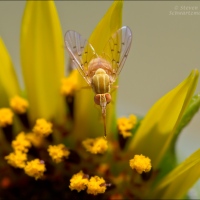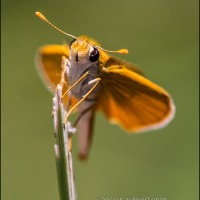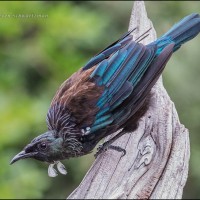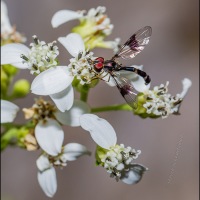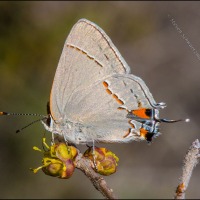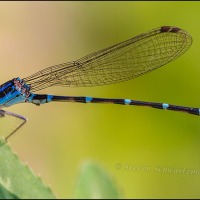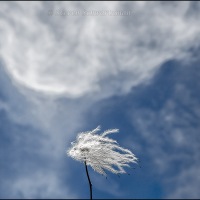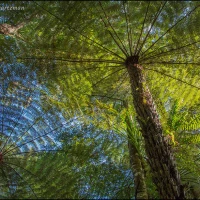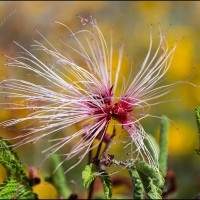Posts Tagged ‘green’
First snow, and later 106°

On the morning of August 10th by the pond along Kulmbacher Dr. in far north Austin I found my first snow-on-the-prairie (Euphorbia bicolor) for 2023. Of course the reference in the common name is to the plant’s white-margined bracts, not to actual snow, as that afternoon’s high temperature of 106°F (42°C) confirmed. In the top photograph, notice the shed exoskeleton of a small spider.
§
§ § §
§
I’ve been reading Christopher Rufo’s new book America’s Cultural Revolution. On page 67, in the middle of a sentence, I came to the words “academia, media,” and the spontaneous part of my brain fused them into “acamedia.” Then the critical part of my brain kicked in and suggested that the first part of that portmanteau might not be transparent enough, and that the one-syllable-longer “academedia” is probably better. Either way, the point is that the dominant views in academia and those in the legacy media have merged and are therefore now indistinguishable. Academia and the mainstream media have both abandoned objectivity for the sake of ideology.
© 2023 Steven Schwartzman
More about talayote
In Great Hills Park on July 16th I photographed not only the flowers and buds of a talayote vine (Cynanchum racemosum var. unifarium), but also a looping tendril and a yellowed leaf.
Oh well, this being a milkweed vine, I guess I should also show you one of its seed pods.
§
§ § §
§
Over the past several years it’s become common for partisans to deny, sometimes strenuously, that the tenets of critical theory or gender ideology or wokeism or whatever you wish to call that conglomerate of beliefs are being implemented in America’s schools. The evidence says otherwise. Look at the beginning of Christopher F. Rufo’s 2022 article “Radical Gender Lessons for Young Children”:
Evanston–Skokie School District 65 has adopted a radical gender curriculum that teaches pre-kindergarten through third-grade students to celebrate the transgender flag, break the “gender binary” established by white “colonizers,” and experiment with neo-pronouns such as “ze,” “zir,” and “tree.”
I have obtained the full curriculum documents, which are part of the Chicago-area district’s “LGBTQ+ Equity Week,” which administrators adopted last year. The curriculum begins in pre-kindergarten, with a series of lessons on sexual orientation and gender identity. The lesson plan opens with an introduction to the rainbow flag and teaches students that “Each color in the flag has a meaning.” The teacher also presents the transgender flag and the basic concepts of gender identity, explaining that “we call people with more than one gender or no gender, non-binary or queer.” Finally, the lesson plan has the teacher leading a class project to create a rainbow flag, with instructions to “gather students on the rug,” “ask them to show you their flags,” and “proudly hang the class flag where they can all see it.”
In kindergarten, the lessons on gender and trans identity go deeper. “When we show whether we feel like a boy or a girl or some of each, we are expressing our GENDER IDENTITY,” the lesson begins. “There are also children who feel like a girl AND a boy; or like neither a boy OR a girl. We can call these children TRANSGENDER.” Students are expected to be able to “explain the importance of the rainbow flag and trans flag” and are asked to consider their own gender identity. The kindergartners read two books that affirm transgender conversions, study photographs of boys in dresses, learn details about the transgender flag, and perform a rainbow dance. At the end of the lesson, the students are encouraged to adopt and share their own gender identities with the class. “Now you have a chance to make a picture to show how YOU identify,” the lesson reads. “Maybe you want to have blue hair! Maybe you want to be wearing a necklace. Your identity is for YOU to decide!”
And all that is just through kindergarten! You can read the full article. In 2021 Rufo had written a similarly revelatory article that began this way:
An elementary school in Cupertino, California—a Silicon Valley community with a median home price of $2.3 million—recently forced a class of third-graders to deconstruct their racial identities, then rank themselves according to their “power and privilege.”
Based on whistleblower documents and parents familiar with the session, a third-grade teacher at R.I. Meyerholz Elementary School began the lesson on “social identities” during a math [!] class. The teacher asked all students to create an “identity map,” listing their race, class, gender, religion, family structure, and other characteristics. The teacher explained that the students live in a “dominant culture” of “white, middle class, cisgender, educated, able-bodied, Christian, English speaker[s],” who, according to the lesson, “created and maintained” this culture in order “to hold power and stay in power.”
You can read that full article, too. So if you hear people deny that American schoolchildren are getting indoctrinated, tell them they’re wrong and point them to these articles.
© 2023 Steven Schwartzman
Verdant
Look how lush the maidenhair ferns (Adiantum capillus-veneris), inland sea oats (Chasmanthum latifolium), and other plants were along the trail between Springfield Park and McKinney Falls State Park in southeast Austin on May 21st. Thanks to recent rain, drops were still falling from the roof of the dark little “grotto” at the center. Below you see what an adjacent stretch of Onion Creek was looking like. The large tree with the interesting roots at the right is a bald cypress (Taxodium distichum).
© 2023 Steven Schwartzman
Rain lily on the cusp of winter
While we normally and understandably focus on the flowers of rain lilies (Zephyranthes sp.), I considered myself lucky on December 21st to at least find the green leaves of one as winter was about to begin. I think you’ll agree the raindrops didn’t hurt.
⥥
⥥ ⥥ ⥥
⥥
Konstantin Kisin, a short clip of whom I linked to yesterday, recently participated in a debate at the Oxford Union in England. A nine-minute video shows him giving reasons why “This House Believes Woke Culture Has Gone Too Far.” Since the posting of that video nine days ago it has gotten over 700,000 views and over 3000 comments on the Oxford Union’s YouTube channel. The video clip has been reposted on many other websites as well. (Update: here’s a transcription of Kisin’s speech.) You can also read an ABC television station’s article about Kisin’s performance at the debate.
© 2023 Steven Schwartzman
Ephemeral green
An intermittent creek in my neighborhood was mostly dry when I visited on December 10th of the recently departed year. Along a section of the creek that still had a little water left in it I did a few portraits of the remaining algae. Patches not far from each other could look rather different, as you see here. In the second view, the spaghetti-like tendril of a vine had somehow gotten embedded in the algae.
✧
✧ ✧ ✧
✧
“America’s Systemic Racism Problem Is Mostly In Woke, Anti-Asian Education Bureaucracies.” That’s the headline in Helen Raleigh’s January 6th article in the Federalist. In case you haven’t heard about this latest scandal in Virginia’s schools, here’s the beginning of the article:
Virginia Gov. Glenn Youngkin began 2023 by asking the state’s Attorney General Jason Miyares to investigate the allegation that officials at Thomas Jefferson High School (TJ) intentionally withheld notifications of National Merit awards from the school’s students and families (most of them are Asians) in the name of “equity” and “inclusion.”
Asra Q. Nomani, a human rights activist and a proud mom of a TJ graduate, broke the latest scandal at the school right before Christmas. According to Nomani, the scandal was initially uncovered by another TJ mom, Shawna Yashar, whose son took the PSAT test. He was recognized by the National Merit Scholarship Corporation “as a Commended Student in the top 3 percent nationwide — one of about 50,000 students earning that distinction.” It was the kind of honor that would have helped his applications for colleges and scholarships last fall had the TJ officials not withheld his award announcement. When the TJ officials eventually notified him of his award, the deadline for his college applications had already passed, which rendered the award useless.
Nomani learned that her son, a graduate of TJ’s class of 2021, was never told by school officials that he was a “Commended Student” in 2020. Even more infuriating is that these two young men’s experiences were not the result of some honest one-time mistake.
Nomani discovered that “the principal, Ann Bonitatibus, and the director of student services, Brandon Kosatka, have been withholding this information from families and the public for years, affecting the lives of at least 1,200 students over the principal’s tenure of five years.” These officials’ actions (or inactions) disproportionally hurt Asian students because the majority of the school’s student body is Asian. By intentionally withholding awards and eventually delivering them late and in a low-key way, these officials robbed the students and their families of chances to celebrate hard-earned achievements.
In addition, these officials caused undue harm to these students’ college applications and scholarships. For some first-generation immigrants with no other financial resources to fall back on, the damage caused by these school officials’ actions could have a lifetime effect, with some students having to settle for less prestigious colleges or be forced to take out more student loans.
After Nomani broke the story, TJ’s director of student services, Brandon Kosatka, justified her* action by insisting, “We want to recognize students for who they are as individuals, not focus on their achievements.” Does she understand that celebrating someone’s achievement and acknowledging someone’s effort is an important part of recognizing students as individuals?
You’re welcome to read the full article.
UPDATE: A January 16th editorial in The Wall Street Journal revealed that even more Virginia schools failed to notify students about their Merit Scholarship awards.
* I assume the her refers to the principal, Ann Bonitatibus.
© 2023 Steven Schwartzman
Inland sea oats arc
Look at the characteristically graceful way inland sea oats (Chasmanthum latifolium) forms arcs.
I photographed these green seed heads along Bull Creek on June 24th.
§
§ § §
§
The latest attempt to redefine a word
In the middle of the 20th century George Orwell, himself a former Communist, pointed out the ways in which authoritarian regimes believe they can control people by redefining words. In 1984, a dystopian novel of the then-future, Orwell went so far as to invent a language that he called newspeak. In that language, for example, people were still allowed to use the adjective free in the sense that a dog is free from fleas but not in the normal sense in which a person has individual liberty.
In previous commentaries I’ve criticized campaigns within the past few years to redefine such basic terms as man, woman, and mother (notoriously recast as a “birthing person”). This week the semantic reformers have targeted the financial term recession. For decades now the predominant rule of thumb for recognizing a recession has been ‘two consecutive quarters of declining growth in the gross national product [GNP].’ Do an online search and you’ll find that definition in dozens of places, including the January 1991 article “Weathering a Weak Economy” in the magazine Black Enterprise. Similarly, a person in a 1989 Congressional hearing had spoken of a recession as “two consecutive quarters of less than zero real growth.” And the 2014 book Understanding National Accounts mentions “the two consecutive quarters of decline in real GDP [gross domestic product] that typically denotes a recession.”
The typically in that last quotation concedes some wiggle room in determining whether a given country at a given time has entered a recession. I’m certainly not opposed to nuance. What I am opposed to is the opportunistic mad scramble that we’ve seen in the United States over the past several days by government officials proclaiming that the standard decades-long indicator of a recession was never really the standard decades-long indicator of a recession—just like women were never really the only kind of people who could give birth.
It was almost fun to watch the hypocrisy. For instance, among the choreographed corps of recession-deniers was current White House economic adviser Brian Deese, who on July 26th insisted that “two negative quarters of GDP growth is not the technical definition of recession.” Investigators, however, soon turned up a statement Deese himself had made in 2008: “What Senator Clinton has said is that of course economists have a technical definition of recession, which is two consecutive quarters of negative growth.”
It wasn’t just government officials who twisted themselves into instant recession-deniers. So did many commenters on television networks, as did newspaper writers, people in charge of social media, and even Wikipedia, which in the past few years has become increasingly biased. As Nellie Bowles reported in the blog Common Sense on July 29th:
The Wikipedia page on “recession” is getting furiously updated. (The crowd-source encyclopedia now contains a note on the “recession” entry that all previous definitions are false: “An outdated version of this article has been widely circulated. Please verify that claims or screenshots you may have seen are consistent with the actual content here.”) The economic historian Phil Magness posted on Facebook about the White House word games with recession and got a warning tagging it as “false information” and adding a “fact check.” Government is inefficient in most ways, but when it comes to coordinating with our social media oligarchs, it’s a well-oiled machine.
You’re welcome to read that full piece as well as a January 28th article by Eric Boehm in Reason entitled “After 2 Consecutive Quarters of Negative Economic Growth, Is America in a Recession?” The subtitle is “Most Americans believe so.”
© 2022 Steven Schwartzman
“Bloom” patterns at Inks Lake State Park
On May 6th we drove the roughly one hour west to Inks Lake State Park, which by coincidence we’d visited exactly one year earlier. Because of the continuing drought, the place wasn’t the coreopsis-covered wonderland we’d found there in the spring of 2019. One thing that caught my attention last week that wasn’t there when we’d last visited, in November 2021, was bright green algae in several places along the lakeline, where the algae contrasted in color with the granite that underlies the region. Shape-wise I saw similarities to the many lichens on the selfsame granite in rocks and boulders.
❖
❖ ❖ ❖
❖
The Bill of Rights consists of the first 10 amendments to the Constitution of the United States. Perhaps the best known of the 10 is the First Amendment:
Congress shall make no law respecting an establishment of religion, or prohibiting the free exercise thereof; or abridging the freedom of speech, or of the press; or the right of the people peaceably to assemble, and to petition the Government for a redress of grievances.
It’s become common these days to hear people say that the First Amendment came first because it states the most fundamental rights of American citizens. As conveniently symbolic as that justification sounds, it’s not true. An article on Thoughtco.com explains:
Drawing on the Magna Carta, the English Bill of Rights, and Virginia’s Declaration of Rights, mainly written by George Mason, James Madison drafted 19 amendments, which he submitted to the U.S. House of Representatives on June 8, 1789. The House approved 17 of them and sent [them] to the U.S. Senate, which approved 12 of them on September 25. Ten were ratified by the states and became law on December 15, 1791.
When the Senate’s 12 amendments were submitted to the states for ratification, the first two of them failed, so the remaining 10 that got approved all moved up two slots. What was originally the third of the 12 amendments became our First Amendment. To learn more of the details, including information about the two amendments that failed in 1789—one of which finally got approved two centuries later—you can read the full article.
© 2022 Steven Schwartzman
Texas mountain laurel buds
On March 18 at McKinney Roughs Nature Park in Bastrop County the buds of a Texas mountain laurel bush were opening. The familiar scientific name Sophora secundiflora has given way to Dermatophyllum secundiflorum.
⦹
⦹ ⦹ ⦹
⦹
People claim lots of things, some seemingly more far-fetched than others. When Copernicus in the 1500s and then other scientists in the 1600s claimed that the earth goes around the sun, rather than the other way around, many people didn’t believe it. It seemed counter to the daily experience of watching the sun move in an arc through the sky above a seemingly immobile earth. Evidence, particularly after telescopes got perfected, eventually showed that the strange claim was true.
In October of 2020, shortly before that year’s presidential election in the United States, the New York Post broke a story saying that Hunter Biden, the son of then-presidential candidate Joe Biden, had brought a laptop computer to a repair shop in Delaware but had never returned to pick it up. As happens in such cases, the unclaimed laptop then became the property of the repair shop’s owner. The laptop per se wasn’t especially valuable, but the data on it was. The laptop’s hard drive contained many photographs showing Hunter Biden doing drugs and cavorting with prostitutes. More importantly, the hard drive also contained e-mails implying that Hunter Biden was getting lots of money from foreign sources in the expectation of access to or influence with Joe Biden.
Given that the main American elections take place early in November, the story could plausibly have been what people have come to call an “October surprise”: condemnatory “information” that a partisan reveals to the public shortly before the election in an attempt to influence people not to vote for the candidate that the partisan opposes. For example, one month before Election Day in 2016 came the release of the Access Hollywood videotape in which candidate Donald Trump was seen speaking lewdly about women. The tape was real, not a fake, and it probably did influence some people not to vote for Trump.
Now let’s return to the 2020 Hunter Biden laptop story. The first question a responsible person would ask is whether the story was true. Might anti-Biden partisans have made it up in an attempt to discredit candidate Biden? Such fakery does sometimes happen, after all, so initially we can’t rule out that possibility—politics is hardly known for its nobility, is it?
Unfortunately, people at many traditional news outlets immediately claimed that the Hunter Biden laptop story was “Russian disinformation,” yet they never brought forth any evidence to prove that it was Russian disinformation. Worse, the social media platforms Facebook and Twitter suppressed even any discussion of the claim, with Twitter going so far as to completely lock the account of the New York Post, the oldest American newspaper still in print.
As becomes an ethical news organization, the New York Post had offered plenty of evidence that the Hunter Biden story was true. The mainstream media not only refused to consider it, but claimed with no evidence that the story was false. That was unethical.
And then there were the 51 former “intelligence” officials who signed a letter saying the Hunter Biden laptop story “has the classic earmarks of a Russian information operation.” They admitted they had no evidence that that’s what it was but kept pushing the disinformation conjecture anyhow. With all their connections, couldn’t they at least have asked around among their current counterparts to find out what they knew about the story and what they were doing to check its authenticity? Actually the letter writers didn’t even have to do that: soon after the letter appeared, the DNI (Director of National Intelligence) and the FBI (Federal Bureau of Investigation) announced that the Hunter Biden laptop story was not Russian disinformation. That made no difference to the many people pushing the “Russian disinformation” narrative.
This past week the New York Times unexpectedly ran a story about Hunter Biden. As the Wall Street Journal Editorial Board put put it on March 18: “The Times waddled in this week with a story on the ‘tax affairs’ of the President’s son, including this gem in the 24th paragraph: ‘Those emails were obtained by The New York Times from a cache of files that appears to have come from a laptop abandoned by Mr. Biden in a Delaware repair shop. The email and others in the cache were authenticated by people familiar with them and with the investigation.” Notice that the admission occurred only in the 24th paragraph of that story. Talk about burying the lead. Apparently the Times figured that that confirmation just barely qualified as part of “all the news that’s fit to print.”
© 2022 Steven Schwartzman
Small frog on a palmetto leaf
On November 11th at the Lady Bird Johnson Wildflower Center the Lady Eve caught site of a small frog on a palmetto leaf (Sabal minor) and called my attention to it.
UPDATE: This appears to be an American green tree frog, Dryophytes cinereus. Austin is at the western edge of the range for that species.
✶
✶ ✶
✶ ✶ ✶
✶ ✶
✶
I invite you to take a look at Michael Shellenberger and Peter Boghossian‘s chart showing the taxonomy of the Woke religion. “We decided to publish the Woke Religion Taxonomy because it was helpful to our own understanding of Wokeism as a religion, and we felt it might help others. The Taxonomy identifies common myths and supernatural beliefs and helps explain why so many people continue to hold them, despite overwhelming evidence that they are false. We are under no illusion that the taxonomy will reduce the power that Wokeism holds over true believers. But we also believe it will help orient those who are confused by its irrationalism, and are seeking an accessible overview. Finally, we are publishing it because we recognize that we might be wrong, either about matters of fact or classification, and hope it will encourage a healthy discussion and debate. As such, we have published it with the caveat that it is ‘Version 1.0’ with the expectation that we will revise it in the future.”
© 2021 Steven Schwartzman
Paloverde portrayed at different scales
Here are two treatments of paloverde trees (Parkinsonia aculeata) that differ in scale and aesthetics. In Austin it’s common to see a paloverde (Spanish for ‘green tree’) springing up on untended ground, like the sapling above that looked so wispy in the northeast quadrant of Mopac and US 183 on August 22nd. A view at that distance doesn’t reveal the many thorns that grow on these trees; the second picture, from September 14th at the Riata Trace Pond, rectifies that.
The long thorn could symbolize the fact that yesterday we got our booster shots of the Pfizer COVID-19 vaccine six months to the day after we’d gotten our second shots. I’m happy to say that although our muscles around the injection sites are achy, our arms didn’t turn either of the prominent colors in this closeup.
What I continue to be not at all happy about is the current American administration’s claim to be “following the science” while refusing to follow the science. Back on August 28th I linked to an article in Science that reported the results of a large Israeli study of the Pfizer-BioNTech vaccine. As the article noted: “The newly released data show people who once had a SARS-CoV-2 infection were much less likely than never-infected, vaccinated people to get Delta, develop symptoms from it, or become hospitalized with serious COVID-19.”
And yet this administration stubbornly denies that proven reality. This régime refuses to accept that people who have acquired protection from COVID-19 by having caught and recovered from the disease should not be subject to vaccine mandates. The people in charge of the government are science deniers.
© 2021 Steven Schwartzman
















